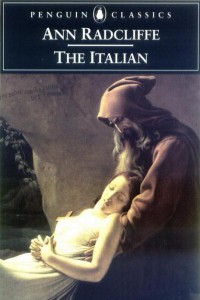This past week I finished The Italian by Ann Radcliffe, meaning that I’ve finally read the Big Three of her novels, the other two being The Mysteries of Udolpho and The Romance of the Forest.
At some point, I’d like to talk about these three in comparison, as well as the consider The Italian alongside more contemporary writing, but I thought it would make sense to start out with a brief review.
The Italian, as in most Radcliffe’s novels, opens with boy-meets-girl. The boy is Vivaldi, a young Neapolitan noble, and the girl is Ellena di Rosalba, an seamstress with a caretaker and mysterious origins. Vincentio di Vivaldi’s wealthy and politically important family intervenes at once to prevent the couple from marrying, but the story really begins when Vivaldi’s mother, the Marquesa, requests the intervention of her confessor, the monk Schedoni. Schedoni, whose origins are every bit as obscure as Ellena’s, skillfully manipulates the nobility and clergy to accomplish the Marchesa’s goals, but from the outset he is clearly driven by his own peculiar ambitions and desire for vengeance.
In one of the better introductions of a villian I’ve encountered, Radcliffe reveals Schedoni as a man who “would sometimes abstract himself from the society for whole days together, or when with such a disposition he was compelled to mingle with it, he seemed unconscious where he was, and continued shrouded in meditation and silence till he was again alone.” “In fact he cared not for truth, nor sought it by bold and broad argument, but loved to exert the wily cunning of his nature in hunting it through artifical perplexities. At length, from a habit of intricacy and suspicion, his vitiated mind could receive nothing for truth, which was simple and easily comprehended.”
Schedoni is “the Italian” referenced in the title and, as hinted by his three-page introduction, the real star of the show.
The Italian is, in many ways, more similar to The Romance of the Forest than The Mysteries of Udolpho. Like Romance, Italian deployed a nuanced, complex plot that reminded me of Raymond Chandler’s work in the depth and number of strategems and counter-strategems. Also like Romance, the novel boasted an economy of plot that was quite alien to Udolpho‘s rambling, weird course. Since this economy is evidently more typical of Radcliffe’s writing than Udolpho pseudo-incoherence, it’s more than a little ironic that the writer has been derided as “delightfully horrid” while showing such ease and skill in some very writerly tricks. The other side of the coin is that Italian‘s impressive execution, in some cases hobbled by pancake-thin characterizations of important players, actually calls attention to its datedness — to its temporal “moment” — and to me it sometimes reads as almost sterile.
For example, the “delayed reveal,” a common Early Gothic and Radcliffe trick, in which a clueless domestic servant talks endlessly of trivialities while a protagonist begs for vital information, is drawn out by pages in this piece. By the third or fourth occurrence, it’s really tedious. And the instant infatuation between Vivaldi and Ellena is so sudden and inexplicable that it lacks even the slim substance of the parallel moment in Romance of the Forest. In the end, all of Radcliffe’s novels are peculiar and inconsistent, but it is Udolpho‘s hypnotic and timeless weirdness that insulates it from obscurity. The Italian is not so fortunate.
The book wasn’t a wash, however. As I said, the early portrait of Schedoni is very powerful, and he is a charismatic presence from beginning to the end. The second half of the novel, which takes the story into the dungeons of the Inquisition, offers a penetrating and surprisingly circumspect look at the institution, as well as its ties with the aristocracy and the larger church.
Two other things argue in favor of The Italian.
First, the Penguin Classics edition includes a nice (and spoiler-free) introduction by Robert Miles, in which he argues persuasively that Radcliffe’s careful treatment of the Catholic Church, the Neapolitan state, and a robust and meaningful “explained supernatural” all contribute to a historical argument about Europe’s need to emerge from its feudal past. While the book captures the sense of nostalgia so prevalent in the Early Gothic novel, its protagonists are oriented toward the future, not the past, in a way that is more eloquent, and perhaps more compelling, than in Radcliffe’s other writings.
Second, I cannot read The Italian without considering it to be a response to Matthew Lewis’ The Monk. Ann Radcliffe’s most famous explanation of her craft came decades later, in her essay “On the Supernatural in Poetry”:
Terror and horror are so far opposite, that the first expands the soul, and awakens the faculties to a high degree of life; the other contracts, freezes, and nearly annihilates them.
While Radcliffe could certainly incorporate “horror” into her own work from time to time, it is clear that she had a clear preference for “terror,” an ennobling experience that illuminated readers with a sense of sublimity and self-awareness. In the light of The Monk and The Italian Radcliffe’s definition is especially revealing. The Monk was England’s most infamous encounter with Gothic prurience, and basically plots the downfall of a priest from one iniquity to the next. Radcliffe’s Schedoni may seem superficially similar to Lewis’ Ambrosio, but she imbues her villain with a magnetic passion and humanity, even while keeping her readers in dreadful uncertainty as to his motives and history. I think that The Italian succeeds best as an answer to The Monk, and on this front, it is dazzlingly spectacular.
